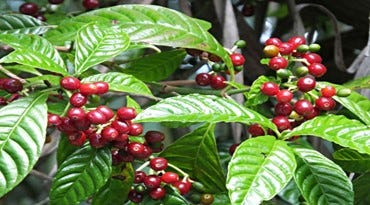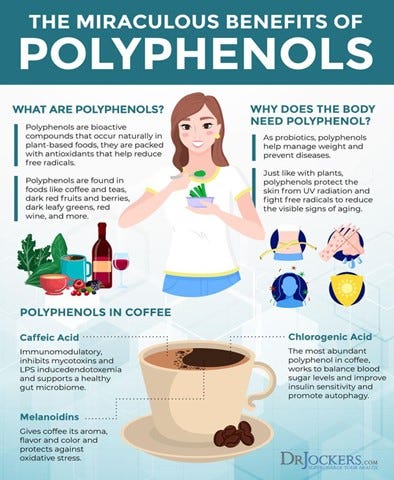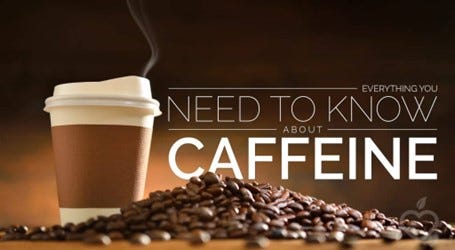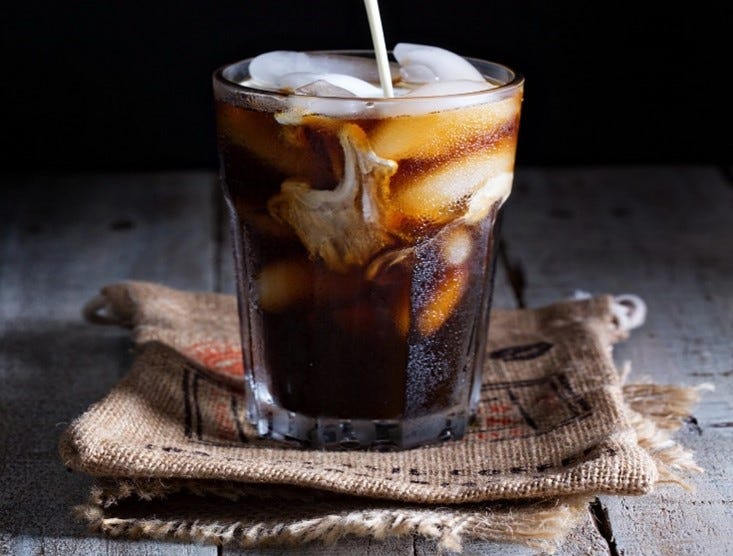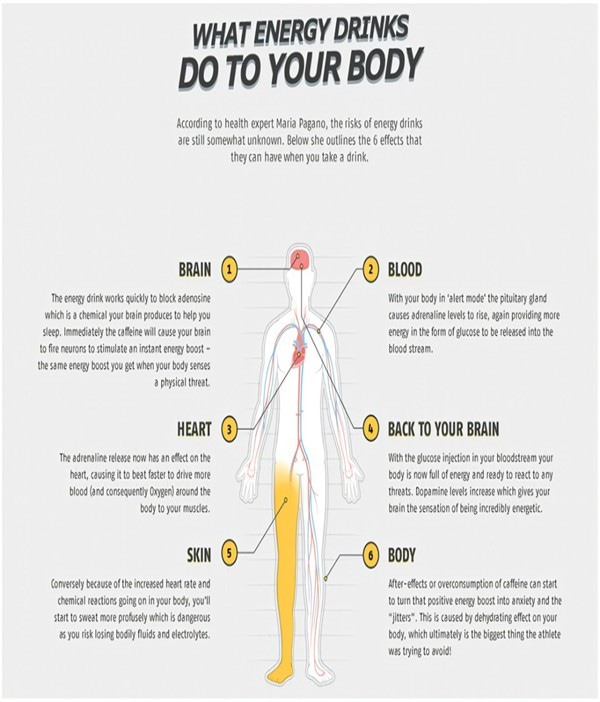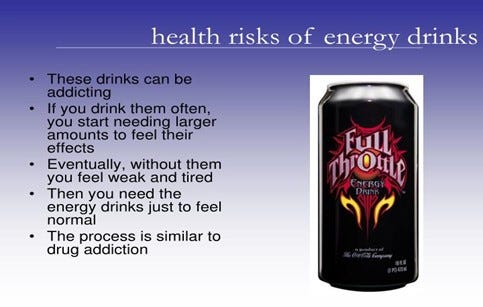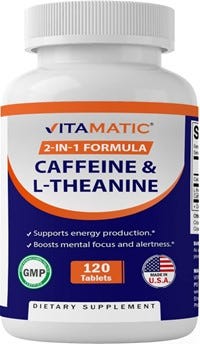COFFEE AND CAFFEINE: MORE THAN A CUP OF JOE
Coffee is an evergreen shrub native to tropical parts of Africa and Asia. Its botanical name is Coffea arabica, also commonly known as Arabica coffee. The seeds of the coffee plant are what we commonly refer to as “coffee beans”. Coffee and black and green teas (no caffeine in herbal teas) provide caffeine which is the most popular drug on the planet, used by millions as a morning stimulant.
THE HISTORY OF COFFEE
Here is a quick look at the history of coffee from Wikipedia.
The first written record of coffee made from roasted coffee beans (botanical seeds) comes from Arab scholars, who wrote that it was useful in prolonging their working hours. The Arab innovation in Yemen of making a brew from roasted beans spread first among the Egyptians and Turks, and later on found its way around the world.
Other scholars believe that the coffee plant was introduced from Yemen, based on a Yemeni tradition that slips of both coffee and qat were planted at Udein (‘the two twigs’) in Yemen in pre-Islamic times.
Arabica coffee production in Indonesia began in 1699 through the spread of Yemen’s trade. Indonesian coffees, such as Sumatran and Java, are known for their heavy body and low acidity. This makes them ideal for blending with the higher acidity coffees from Central America and East Africa.
There are two primary species of coffee plants cultivated for commercial production:
Arabica (Coffea arabica): Known for its smooth, complex flavors and lower caffeine content. Arabica is the most popular coffee species. It is typically grown at higher altitudes and requires more care due to its susceptibility to pests and diseases. It is by far the most popular coffee worldwide.
Robusta (Coffea canephora): Robusta beans are known for their strong, bold flavors and higher caffeine content.
COFFEE AS IT FLIPS IN AND OUT OF PUBLIC FAVOR AND WHY
The information on coffee is confusing to the public. Health authorities routinely changing their minds about coffee is no help either.
One day it is demonized, the next lauded. So, I decided to take my readers on a tour of coffee/caffeine and its pros and cons on this week’s exciting episode of The Medical Underground. I need some dramatic music with that introduction. However, I digress.
Below is a photo of a coffee plant that has already flowered and has been pollinated and is now setting seed, with her red coffee beans.
So many of us, look forward to our morning brew of coffee, to fully awaken us, jumpstart our days, and to energize us. Caffeine works wonders to make your brain more alert, increasing your awareness of the environment around you, quickens your thought processes improving your response times. All of which certainly come in handy in our day to day lives.
Truth be told, in my medical office my nurses make fun of me because every day I have a large ice coffee on my desk and ¾ of it is still there in the afternoon. I just am so busy I don’t get around to drinking it. For that reason, I prefer to take caffeine tablets combined with a little theanine, and it works wonders. More on that later.
Some of the “bad press” coffee has gotten over the years is due to the difficulty in studying a dietary component in isolation, without the other bad habits. For example, heavy coffee drinkers often are both obese and smokers, many times quite heavily. This will certainly skewer the results against coffee.
Things got so bad that in 1991 the World Health Organization (WHO) declared that coffee was a carcinogen (causes cancer), by 2016 coffee was exonerated and back in “the experts” good favor, where it remains today, after studies concluded just the opposite, that in fact coffee prevented several kinds of cancers once smoking was factored in.
Of late, the tide continues to flow in coffees favor, with many studies touting its benefits. Even the Mayo Clinic now says that coffee shows some protection against:
Type Two diabetes
Parkinsons disease
Liver disease and liver cancer
Cardiovascular disease and heart attacks
Strokes
However, we are getting a little ahead of ourselves, let’s first look at what is actually in your morning cup of Java.
Coffee is a witch’s brew of over a thousand different chemicals, the most important of which is caffeine. Coffee also is a significant source of antioxidants, the amounts of which vary depending on the variety of coffee plant and most importantly the soil in which it is grown. Besides caffeine, coffee is a source of vitamin B2 (riboflavin), magnesium, and my old friend the polyphenols, of whom I have touted their many benefits in earlier Substacks.
POLYPHENOLS
As I have mentioned in the past, polyphenols have many health enhancing properties beyond being strong anti-inflammatories as well as antioxidants. Here is a table touting some of the many health benefits of polyphenols and why I like them so much:
There are three different polyphenols in coffee, that combine to give it taste as well as its many health benefits, which are caffeic acid, melanoidins, and chlorogenic acid.
Caffeine is the major player in the many effects of coffee, so let us take a look at exactly what caffeine does for us.
On average, one cup or eight ounces of brewed coffee will contain 95 mg of caffeine. The same amount of instant coffee will contain 60 mg of caffeine and even decaf has 4 mg of caffeine. Surprisingly, a “moderate” intake of coffee is considered to be three to five cups a day. As most coffee drinkers know, caffeine takes about 45 minutes to be absorbed into your blood stream after being broken down in the liver, after drinking your first cup of the day. However, some coffee drinkers feel the effects of their first cup of Joe within fifteen minutes, while others take up to two hours to get their “jolt” of caffeine. Some of the variation depends upon the content of your stomach. If it contains lots of fiber, that will weakly bond the caffeine and slow its absorption into your blood.
Kinky Fact/Nerd Food: Skip to the next section if you dislike science. Caffeine is one of the very few substances that I know of that is both fat and water soluble. That unique property scientifically is known as amphiphilic. The only other ones that I am aware of is alpha lipoic acid (ALA), and the phospholipids.
Why is that important you innocently ask? Good question grasshopper. Being both fat and water soluble allows a substance to cross both into cells as well as across barriers such as the blood brain barrier and enter the brain. Once in the brain, coffee works its magic by stimulation of different centers.
Once caffeine is broken down in the liver and absorbed, depending upon the person, it will remain in your blood from 1.5 to 9.5 hours. Certain factors change that dynamic: smoking increases its destruction and taking oral contraceptives or being pregnant delays its destruction, sometimes in the third trimester so much that it stays in the blood for 15 hours!
Other Sources of Caffeine:
Espresso. 1 shot or 1.5 ounces contains about 65 mg caffeine.
Tea. 1 cup of black tea contains about 47 mg caffeine. Green tea contains about 28 mg. Decaffeinated tea contains 2 mg, and herbal tea contains none.
Soda. A 12-ounce can of regular or diet dark cola contains about 40 mg caffeine. The same amount of Mountain Dew contains 55 mg caffeine.
Chocolate (cacao). 1 ounce of dark chocolate contains about 24 mg caffeine, whereas milk chocolate contains one-quarter of that amount.
Guarana. This is a seed from a South American plant that is processed as an extract in foods, energy drinks, and energy supplements. Guarana seeds contain about four times the amount of caffeine as that found in coffee beans. Some drinks containing extracts of these seeds can contain up to 125 mg caffeine per serving.
I always thought guarana berries were kind of creepy looking. They look like a cluster of red seeds with eyeballs.Energy drinks. 1 cup or 8 ounces of an energy drink contains about 85 mg caffeine. However, the standard energy drink serving is 16 ounces, which doubles the caffeine to 170 mg. Energy shots are much more concentrated than the drinks; a small 2 ounce shot contains about 200 mg caffeine.
Supplements. Caffeine supplements contain about 200 mg per tablet, or the amount in 2 cups of brewed coffee.
Now that we know the caffeine content of different drinks, let us look at what caffeine does for us.
Some benefits of caffeine are better known than others, weight loss is one that a lot of people don’t realize. Caffeine has the dual effect of decreasing your appetite as well as boosting your metabolism. That is a nice double whammy that helps you lose weight.
There are some variations on how to make coffee beyond using hot water, that are quite interesting, let’s take a deep dive into one of the most fascinating, cold brewing.
WHAT IS COLD BREW COFFEE AND WHY IT IS DIFFERENT THAN ICED COFFEE?
Cold brew coffee is very different from iced coffee and is made in a different way. Cold brew coffee is made by steeping ground coffee in room temperature water for about 12-18 hours or longer if you so desire, in a covered vessel of some type. You then strain out the coffee grounds and either drink it as is, pour it over ice, or refrigerate it. If the taste is too strong, you can dilute it with water to your liking.
The ratio of coffee to water that you can use varies according to individual taste preferences. The ratio of coffee to water usually varies between 4:1. all the way up to 10:1. I personally like a stronger coffee flavor, so I naturally would use more beans to water.
As you would expect at this point, anything can be found on Amazon and cold brew coffee is no exception. They even brew it twice as strong to get twice the caffeine. Normally, cold brew coffee has the same caffeine content and polyphenols etc. as hot brewed coffee.
However, coffee aficionados do say there is a big difference in the flavor, with cold brewed being less acidic, since the heat of hot brewing draws acids out of the coffee grounds.
You should note, you cannot make cold brew by sticking it in your refrigerator. The problem is that trying to brew coffee or steep it at a cold temperature vastly slows down the extraction process from the coffee, resulting in a weak, bland poor tasting diluted coffee.
Iced coffee is simply hot coffee poured over ice or cooled in a refrigerator (after it is hot brewed). Typically, as the ice melts, it dilutes the coffee, and by extension its taste.
One last thing on cold brewing coffee. It is often brewed in a concentrated form, in what is cleverly called cold brewed concentrate. You then take this and add water to dilute it to your taste.
Okay, I have digressed enough into the world of cold brewing, now let’s get back to coffee and its benefits.
HEALTH BENEFITS VS CONCERNS OF DRINKING COFFEE
I would be remiss if I didn’t also point out any health concerns that might be associated with coffee intake. There are not many, and most are well known. Here is a good table showing both sides of the coffee argument, followed by a table showing caffeine’s benefits.
HOW DOES THE CAFFEINE LEVELS OF DIFFERENT CAFFEINATED DRINKS COMPARE?
Patients frequently ask about the difference in caffeine content among the various coffee preparations and other caffeinated products like cola, chocolate etc. Not surprisingly, there is a range of different caffeine levels. Let us take a look.
ENERGY DRINKS: ARE THEY SAFE TO DRINK?
And finally, let’s take a look at Energy Drinks and see how much of a kick in caffeine they have, keeping in mind that caffeine is only one of the stimulants they contain.
Most Energy Drinks contain B vitamins, taurine, ginseng, green tea extract, green coffee extract, sugar, guarana, gingko, and carnitine. Naturally these ingredients vary among different manufacturers, but those are the usual suspects.
With all those stimulants in one concoction, are they a benign jump-starting drink, safe to give you a jolt of energy? Or are we shooting ourselves in the foot by drinking them? Here is what the Medical Underground thinks.
As you can see from the above chart, the caffeine and caloric values vary wildly. However, that being said, even the strongest coming in at 300 mg of caffeine compares to a cup or two of coffee.
First, let’s look at the good news on Energy Drinks: they will give you a jolt of energy, and increase your minds awareness and focus. Certainly, for those of us who went through college and graduate schools, getting an energy boost often times made all the difference. God only knows, how many of us could use an improvement in our alertness and focus, but at what cost?
Most of the additional ingredients other than caffeine are beneficial on their own. The problem lies in their combination, which often produces problems. Here is a list of medical problems resulting from drinking Energy Drinks.
Anxiety and panic attacks
Palpitations and cardiac rhythm problems such as tachycardia
Chest pain and elevated blood pressure
Weight gain and tooth decay (primarily from the sugar intake)
Diarrhea, nausea and bowel problems
Frequent urination and dehydration
Headaches
Mental status changes (confusion and hallucinations)
Strokes (always a bummer)
Insomnia
As you can see, by themselves Energy Drinks are potentially bad enough, add alcohol to the mix and you have real problems. Why is that you nervously ask, desperately trying to remember if you ever did just that? The reason is that the stimulation of the Energy Drinks masks the intoxicating effect of the alcohol, making you feel less drunk than you are, thus many people keep drinking, ultimately getting themselves completely intoxicated.
The CDC reports that people who mix alcohol and Energy Drinks are four times as likely to binge drink in comparison to those who do not mix them! Many times, dangerously intoxicated, and finding themselves either arrested or in the local ER. Those who mix the two are also more likely to engage in risky behaviors such as unprotected sex, drunk driving etc.
Sound familiar? Am I the only one who thinks this sounds like many of us, especially in the Seventies? And that was without Energy Drinks, LOL. However, once again I digress.
For those reasons, The Medical Underground feels strongly that Energy Drinks and alcohol should never be taken together.
Below is a great table that delves into some of the other lesser-known side effects of drinking Energy Drinks.
There is even a dark side of the need for more and more stimulation as each stimulant’s effects wane over time, a quasi-addiction type of scenario, albeit very weakly addicting.
In general, the Medical Underground does not recommend drinking Energy Drinks if you are a child or adolescent, pregnant, or have an underlying cardiac disease and hypertension (high blood pressure), or are on multiple medications, due to potential adverse drug to drug interactions.
HOW DOES THE MEDICAL UNDERGROUND SUGGEST BOOSTING YOUR ENERGY WITHOUT ENERGY DRINKS?
To give the proper answer, that would require a full article of its own, that is beyond the scope of this white paper. But let’s just take a quick look at what you can do to boost your daily energy.
The number one thing you can do is to get a full night’s sleep, in complete darkness, without any EMF emitting electronic devices such as telephones and chargers in your bedroom.
Hydration is also key, just like the old car batteries that you needed to add water to generate power, your body needs to be well hydrated to generate energy, The Medical Underground advises using your tongue as a barometer of your hydration, meaning your tongue must be wet for you to be fully hydrated, if not, keep drinking water. Nothing will zap your energy more than being dehydrated.
Avoid simple carbohydrates or very concentrated sweets which pack a lot of sugar, leading to spikes in insulin production in order to assimilate the sugar surge. These insulin spikes sometimes are overdone, and the result is a crash in your blood sugar levels.
It happens so often to people after eating a lunch with a Coke or some other sugar drink. About an hour or so after lunch they crash and want to take a nap.
Avoid very sugary food or beverages and instead opt out for complex carbohydrates which break down slowly and avoid those blood sugar/insulin spikes and the following hypoglycemia (low blood glucose levels).
Quite paradoxically exercise will also help your energy levels, it has a tendency to charge up your body and keep it running like a well-oiled machine.
There are vitamins you can take that will also provide energy, such as all the B vitamins (together known as B complex). I would take the methylated version of B complex, in case you are MTHFR positive. They are available from the Evil Empire (Amazon).
Alpha Lipoic Acid (ALA) also provides energy along with CoQ10. The Medical Underground recommends 600 mg of ALA and 200 mg of CoQ10 daily with a fatty meal to help increase their absorption.
In my medical practice, I give B12 shots monthly to many patients who suffer with fatigue (it also helps memory and early dementia quite well). The dose is 1,000 mg intramuscularly once a month. Patients love it and many request it every month, noting how good it makes them feel.
One other supplement that is widely ignored in mainstream medical circles is one of my personal favorite, iodine. Contrary to popular medical belief, the thyroid is not the only part of your body that needs iodine, EVERY CELL NEEDS IODINE.
Iodine supplementation is especially critical for patients with hypothyroidism. Unfortunately, almost everyone is iodine deficient due to our processed food junk diets and especially because the soils in which our crops are grown are horribly deficient in not only iodine but most minerals and trace elements.
You can take iodine in various forms from Lugol’s solution to Iodoral tablets. However, my personal favorite is kelp. Kelp is a type of giant seaweed that grows in “forests” along most coastlines. It is organic, full of iodine and many other minerals and trace elements and contains all of the “essential” amino acids. So called because our bodies cannot manufacture them and hence, they must be obtained in our diets.
It is in an organic form that our bodies recognize and readily absorb and utilize. Many times, patients have told me that after a short time of being on iodine they feel as if they are awakened, and a veil of fatigue has been lifted off of them. It has no downside and many other benefits.
You can even make healthy natural drinks that can boost your energy without the health risks of Energy Drinks. The internet is full of various recipes, many of which are both delicious and healthy. Here is an example of one:
CAFFEINE TABLETS
One last note for those of you who prefer taking your caffeine in pill form, which I am very guilty of. There are ways you can mitigate any untoward side effects of the caffeine; one such is to seek out caffeine supplements that also contain the amino acid theanine.
What theanine does is it blunts the adverse effects of caffeine such as anxiety and tachycardia (fast heart rate), by promoting relaxation and decreasing anxiety and its resulting rapid heart rate. It is a wonderful combination and if you decide to take caffeine in tablet form for whatever reason, the Medical Underground recommends that you find a caffeine/theanine combination supplement, for which there is no downside.
The Medical Underground takes a conservative approach to its recommendations on the use of caffeine to its patients/readers. In a nutshell, we are all adults, and our jobs requirements and life stresses often drive us to seek out stimulants such as caffeine. There is nothing right or wrong about drinking coffee, tailoring it to your specific needs, or taking it in pill form if that works for you.
MODERATION IS KEY TO ALL THINGS IN LIFE, INCLUDING CAFFEINE INTAKE. I would not go beyond three cups a day or a max of 400 to 600 mg of caffeine daily. But hey, we are all adults, and you might just need more for a short time and that is alright. Stop being so tough on yourselves. It is a little indulgence that you should enjoy, not stress over. Let’s face it, living in New England, on some of those bitterly cold mornings, nothing beats a hot cup of coffee, warming your hands and body.
Well, that concludes yet another exciting episode of The Medical Underground. As always, I hope you found it both entertaining and educational. If so, please do me a huge favor and tell your friends and family about the Medical Underground.
If you are foolish enough to not have become a free subscriber yet, then hit that subscribe button and improve your life in leaps and bounds.
If you are already a free subscriber than PLEASE STEP UP AND BECOME A PAID SUBSCRIBER, SHOWING ME THAT YOU TRULY APPRECIATE ALL THE HARD WORK IT TAKES TO BRING YOU THESE CUTTING-EDGE ARTICLES WEEKLY. It is only a few bucks a month and it is GREATLY APPRECIATED.
Until our next meeting, May God Bless You and Your Family and the United States of America. And for those of you who, like me, are believers in Jesus Christ, always remember for us: Miracle Shall Follow Miracle and Wonders Shall Never Cease.
This disclaimer provides that such medical information is merely information – not advice.
If users need medical advice, they should consult their doctor or other appropriate medical professional.
***Copyright © 2023-24 by Dr. Ralph La Guardia, MD
All rights reserved. This article or any portion thereof
may not be reproduced or used in any manner whatsoever
without the express written permission of the publisher
except for the use of brief quotations in an article review.






